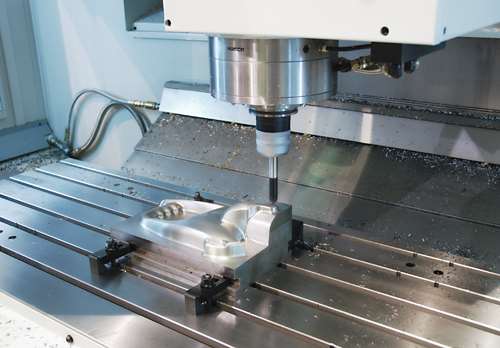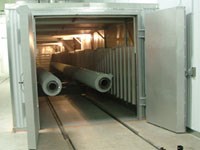The Heavyweights
Thermoset powder coatings provide excellent finish quality in a one-coat process.
Thermoset powder coatings provide excellent finish quality in a one-coat process. A great alternative to liquid coatings for environmental purposes, their combination of toughness and environmental compliance makes them an attractive option. But powder coatings also require significant metal temperature to achieve full cure, and that's no small feat when heavy products are involved.
At first glance, a business that manufactures bulk storage and material handling equipment for huge agricultural installations—some weighing as much as 20 tons—may seem an unlikely candidate for powder. Manufacturer Laidig Systems, however, is making it work.
Featured Content
Manufacturing Big Products
Mishawaka, IN-based Laidig specializes in providing customized solutions for the storage and reclaim of materials with poor material flow characteristics or other special handling requirements. The company provides solutions to bulk storage such as biomass (i.e. wood chips, corn cobs), petroleum coke, crushed coal limestone, fly ash, cement, grains, fertilizers, pellets, and a variety of recycled materials. And they're powder coating those outfits with massive systems specially designed to handle very large and heavy parts.
Jon Laidig built his first bottom reclaim system for silage in 1961. Dedicated to designing and building a more reliable and rugged reclaimer, he founded Laidig Inc. in 1964 and began a tradition of innovation and quality that has been handed down to his son, Wyn. Laidig is now recognized as an industry leader in the bulk storage and reclaim industry, specializing in screw-type bottom reclaimers in silos, domes and open piles. The company has built thousands of bulk storage and reclaim systems worldwide, with new system designs continuously introduced to incorporate the latest technology and meet the new challenges.
In early '80s, the company built a powder coating system designed for smaller, lighter products in the agricultural equipment market. That system featured a hand-held pressure washer to clean the parts. Excess moisture was blown off with a hand-held compressed air nozzle and the parts were dried in the same oven used for curing the powder. The system would handle parts that were 3 x 5 x 8-feet long. The light-duty conveyor was rated for a scant 75 lbs per hook site maximum.
As the years passed, the products that Laidig needed to coat got bigger and heavier and could no longer fit through the system. Hand washing was inadequate for some of the substrates with mill scale and other inorganic soil, and large parts that required blasting were sent out to another facility, thus causing delays in production.
Meeting Big Demand
The pressure of larger sizes, tighter delivery schedules and increases in contract work drove the company to consider a major overhaul of its coating operation. In 2009, Laidig completed a major expansion of its facilities, resulting in more than 100,000 ft2 of heavy manufacturing floor space.
Included in this expansion was a new blasting and powder coating facility allowing finishing and powder coating of very large parts on a batch line. They also installed an automated system that operates at 3 - 6 FPM and can handle parts up to 7 x 9 x 15 ft and weighing up to 4,800 lbs on a 6-inch I-beam rail system. Design, engineering, manufacturing and finishing can now be done under the same roof providing a seamless, integrated process from start to finish.
The automated line is designed for parts that would be considered very large at most facilities but are Laidig's "smaller" components. Parts are hung on the line and cleaned in a 3-stage washer that has a low-temperature product that cleans and applies iron phosphate in the first stage (100 sec). The residual chemistry is rinsed off with a tap water rinse of 60 sec followed by a post-treatment seal rinse of 40 sec. All of the make-up water in the washer is filtered through reverse osmosis (RO), so the water used in the system is very clean for more effective treatment. Water in stage two is counter-flowed and used for makeup water in stage one. Overflowed water is sent to a 2,000-gal holding tank and then hauled away when the tank is full. The first time the holding tank was emptied was six months after start-up, so the system does not waste much water. Cleaning is followed by a convection dry-off oven of 8 min to remove moisture and then cooled by ambient air for 8 min before powder coating.
The powder booth is 13 ft wide x 20 ft long with cartridge collectors on both sides. The two manual applicators work inside the booth to provide access to all areas of the parts using Nordson prodigy powder spray guns. The prodigy guns provide excellent Faraday cage penetration and the ability to deliver powder through a long hose with very little velocity or other problems that can occur in systems with long hoses.
The convection cure oven is a two-pass oven that provides 39 min of cycle time. The heaviest steel coated on the conveyor line is 1-inch-thick steel.
That's One Big Batch
One of the best ways to manage a wide variety of parts is to have a special system to handle the largest parts that do not fit well with the rest of the components. If one system is built to run the very large parts, it may not be a good fit for the balance of the products and the system cannot be run efficiently.
Laidig processes some very large parts that do not fit through the conveyor line. To accommodate these components, they have installed a batch operation that can process parts up to 8 ft wide x 10 ft high x 70 ft long and weighing as much as 30 tons in their batch operation.
The system includes a blast room that is 14 ft wide x 65 ft long. Parts are pressure blasted by hand using 70-grit aluminum oxide. The system is capable of processing augers over 60 ft long and weighing as much as 20,000 lbs.
Previously, the outside blast service was a problem because it often delayed shipment. As a company committed to on-time delivery, Laidig had to have that blast system in-house. "If we were going to invest in a new powder coating system, we needed to have that capability," says Senior Vice President Tom Lindenman.
The powder booth is 14 ft wide x 24 ft long with two collectors like the conveyor booth. None of the over-sprayed powder—a stock gray color and accent orange in addition to several custom colors—is collected for reuse.
The convection cure oven for the batch system is 12 ft wide x 80 ft long. Parts are loaded onto carts with an overhead crane and then moved through the system on 3-inch crane rails mounted on the floor. The carts are then moved from one station to the other with a motorized mover.
The two systems fit into the new building expansion and take up a space that is approximately 75 ft wide x 250 ft long (around 19,000 ft2).
Laidig now has a wide variety of different products and sizes. With the exceptional size of the system, they have the capability to run parts that only a handful of powder coaters in North America can coat.
"During the construction process, Jerry Cunningham of Midwest Finishing Systems, Inc. told us that we really had something unique from a size perspective and we should consider selling our finishing services," says Lindenman. "We had never seriously considered this before, but we are now selling our fabrication and finishing services."
With a system that can handle parts 75 ft long and weighing 20,000 lbs, they may find some interesting jobs.






















